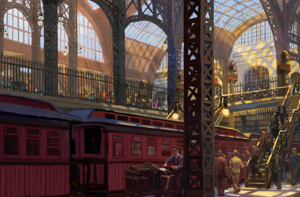Skidmore Owings & Merrill (SOM), Foster + Partners, and Kohn Pedersen Fox (KPF) have been retained as architects for a multi-billion-dollar-project to redevelop New York City’s Pennsylvania Station district, parties close to the deal confirmed on Friday.

Bud Perrone, a spokesperson for the project’s developers, a joint venture of the Related Companies and Vornado Realty Trust, acknowledged that the three architecture firms are involved. Another source involved in the design of the project told RECORD that Foster will prepare the master plan for a site that includes the existing Penn Station, Madison Square Garden (MSG), and two office towers, One and Two Penn Plazas. This plan calls for razing MSG and capping the subterranean train station with a large glass dome.
Errol Cockfield, a spokesperson for the Empire State Development Corporation (ESDC)—the state agency involved in organizing development between private and public interests—confirmed much of the project’s scope. The redevelopment plans include SOM’s previously announced transformation of the Farley Post Office, which the ESDC purchased in March at the southwest corner of 33rd Street and 8th Avenue, into a new Moynihan Station that would augment Penn’s existing—and at-capacity—infrastructure. Cockfield says that the low-rise podium of One Penn would likely be razed, but that the tower would remain and that Two Penn would only be re-skinned. (RECORD’s offices happen to be located in Two Penn Plaza.)
Cockfield says that the ESDC has yet to assemble a timetable for making the designs public, or for the phases of development, but he did say that a scoping session would occur before summer’s end. This session will establish the amount of square footage that the development might contain and prepare rudimentary drawings for how it will be divided. “Some of this is still in flux and people want answers and there is frustration in some corners,” Cockfield says. However, other sources tell RECORD that environmental review hearings are expected to begin this fall. A draft Environmental Impact Statement was completed for the Moynihan project in 2006.
The destruction of McKim Mead & White’s original 1910 Penn Station, in 1964, is largely credited with establishing the historic preservation movement in the U.S. Charles Luckman Associates designed the replacement station, MSG, and office complex, but the public has never quite embraced them. Historian Vincent Scully once wrote that in the old Penn Station, “one entered the city like a god,” while in the new subterranean complex “one scuttles in now like a rat.”
In recent years, the site has been the subject of much speculation. A source involved in the design of the redevelopment has told RECORD that Two Penn Plaza would also be razed to allow for wholesale redevelopment of the area. Planned new structures might include 5.5-million-square-feet of retail, restaurant, hotel, and office space designed by SOM. Additionally, for a site at the corner of 34th Street and 7th Avenue, KPF would design a 2-million-square-foot skyscraper that will be taller than the Empire State Building, located just two blocks away.
SOM’s plan to turn the Farley Post Office building—designed by McKim Mead & White and completed in 1913—into Moynihan Station could act as the front door to a relocated MSG to the west, as well as house retail space that may include a large department store. Cockfield would not confirm whether or not other architects are involved in this project, but he said that Amtrak or New Jersey Transit will likely call Moynihan home. Currently, those two rail services and the Long Island Rail Road jockey for space in overcrowded Penn underneath MSG. Six adjacent subway lines add to the congestion.
David Childs, FAIA, a partner with SOM, says that his firm is mainly focusing on the Moynihan project. “It’s going to be one of those great stories, but if we finish by 2012, we’ll be lucky,” he says. After numerous starts and stops, that project was put on hold in 2006 when state government officials, including assembly speaker Sheldon Silver, withheld approval until a plan for the entire district could be put forward for review.
Perrone, who is with Rubenstein Communications, says that there are on-going discussions between the developers and various state and local agencies, including the ESDC, the City of New York, the Port Authority of New York and New Jersey, the railway services, and the state government.
Separately, plans were announced last winter for the destruction of McKim Mead & White’s 1918 Pennsylvania Hotel, located at the northeast corner of 32nd Street and 7th Avenue, to make room for a hotel tower to be designed by Pelli Clarke Pelli Architects and developed by Vornado. That building’s demolition will leave only the Farley building as the last vestige of the celebrated architects’ legacy in the Penn Station district.
Children’s Book Celebrates Old Penn Station
Children’s author and illustrator William Low was only a child when the original Pennsylvania Station was destroyed in 1964—a seminal event in the history of the modern preservation movement. Although the 48-year-old Low has no memories of McKim Mead & White’s 1910 masterpiece, as a commuter he is now very familiar with its replacement.
“It’s a horrible place,” Low says. “I hate the way that pedestrian traffic flows because there are so many bottlenecks. There’s a gigantic schedule sign right underneath the escalator and I think to myself: who’s the knucklehead who put it there?”
Low channeled this frustration into creating his master’s project at Syracuse University—a series of illustrations that eventually became Old Penn Station, a children’s book published this spring by Henry Holt. The book doesn’t contain a single image of the new station, much less Madison Square Garden or the Two Penn Plaza office tower that occupy the site today, but instead celebrates only the original building. For Low, this was a conscious choice.
“It was an interesting test to see how I might create a body of work on something I’d never seen before: to use photographs, architectural drawings, and interviews to piece it all together in my mind,” he observes. Working back and forth between acrylics, oil paints, and digital Photoshop imagery, Low successfully captured the dappled suffusion of light in McKim Mead & White’s commuter palace.
In the end, Low believes, focusing on the original building’s gentle beauty proved a better decision than contrasting it with the ugliness and failure of the current site. “There are too many books about that, but this is a children’s book and I didn’t want it to be doom and gloom,” he observes. “I decided to make it about Penn Station’s legacy as a symbol for preservation and what it’s become as a martyr. It’s a reminder that buildings are not disposable—they are the heart and soul of all great cities.”






Post a comment to this article
Report Abusive Comment